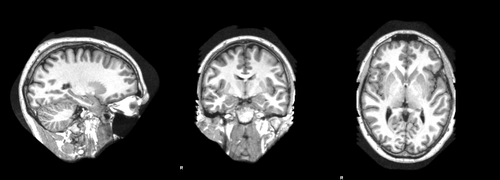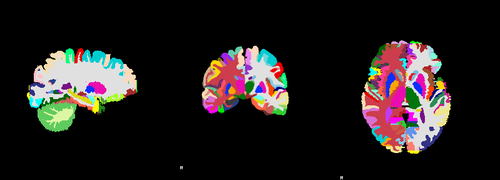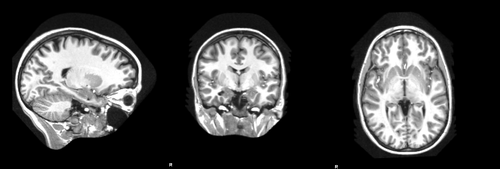Difference between revisions of "NiftyReg Tutorial Segmention Propagation"
(Created page with "test") |
|||
| (2 intermediate revisions by the same user not shown) | |||
| Line 1: | Line 1: | ||
| − | + | Segmentation propagation uses image registration to transfer segmentations (or labels) from the space of one image to the space of another. | |
| + | |||
| + | Assuming a template image (template.nii) and its associated segmentation (labels.nii), on can transfer the label information into the space of another image (new_image.nii). | ||
| + | For this example, we used the file 1000_3.nii from [http://www.neuromorphometrics.com neuromorphometrics] and its associated segmentation as template and subject 1001_3.nii from the same database as new image. Below are shown the ortho-views (mid-plane along each axis) of the three input images: | ||
| + | [[File:Template.png|center|500px|thumb|template.nii]] | ||
| + | [[File:Labels.png|center|500px|thumb|labels.nii]] | ||
| + | [[File:New image.png|center|500px|thumb|new_image.nii]] | ||
| + | |||
| + | |||
| + | First step is to globally (affine) register the image, the template.nii image is used as a floating image and the new_image.nii image is used as a reference: | ||
| + | :<code> reg_aladin -ref new_image.nii -flo template.nii -res ref_template_flo_new_image_affine_result.nii \</code> | ||
| + | ::<code> -aff ref_template_flo_new_image_affine_matrix.txt</code> | ||
| + | The following images show the difference images before and after the affine registration. | ||
| + | [[File:InitialDiff.png|center|500px|thumb|Difference image prior to registration]] | ||
| + | [[File:AffineDiff.png|center|500px|thumb|Difference image after affine registration]] | ||
| + | |||
| + | The affine matrix obtained with reg_aladin, ref_template_flo_new_image_affine_matrix.txt, can now be used to initialise the non-linear registration step: | ||
| + | :<code>reg_f3d -ref new_image.nii -flo template.nii -res ref_template_flo_new_image_nrr_result.nii \</code> | ||
| + | ::<code>-aff ref_template_flo_new_image_affine_matrix.txt -cpp ref_template_flo_new_image_nrr_cpp.nii</code> | ||
| + | The following image shows the difference after the non-linear registration. | ||
| + | [[File:NonLinDiff.png|center|500px|thumb|Difference image after non-linear registration]] | ||
| + | |||
| + | By using the two commands above, we used the default parameters for both reg_aladin and reg_f3d. To see all available options, see <code>reg_aladin -help</code> and <code>reg_f3d -help</code>. | ||
| + | |||
| + | The non-linear transformation parametrisation, ref_template_flo_new_image_nrr_cpp.nii, can now be used to propagate the labels.nii image into the space of template.nii. | ||
| + | Since the labels are binary, we specify to use a nearest-neighbor interpolation scheme: | ||
| + | :<code>reg_resample -ref new_image.nii -flo labels.nii -res propagated_labels.nii \</code> | ||
| + | ::<code>-cpp ref_template_flo_new_image_nrr_cpp.nii -inter 0</code> | ||
| + | Note that while resampling, only the non-linear parametrisation is specified, not the affine. The non-linear parametrisation contains the affine since it was used to initialise the non-linear registration. | ||
| + | |||
| + | Images below show the propagated labels into the space of new_image.nii, with no registration, with affine only and with non-linear registration. | ||
Latest revision as of 15:49, 9 March 2015
Segmentation propagation uses image registration to transfer segmentations (or labels) from the space of one image to the space of another.
Assuming a template image (template.nii) and its associated segmentation (labels.nii), on can transfer the label information into the space of another image (new_image.nii). For this example, we used the file 1000_3.nii from neuromorphometrics and its associated segmentation as template and subject 1001_3.nii from the same database as new image. Below are shown the ortho-views (mid-plane along each axis) of the three input images:
First step is to globally (affine) register the image, the template.nii image is used as a floating image and the new_image.nii image is used as a reference:
reg_aladin -ref new_image.nii -flo template.nii -res ref_template_flo_new_image_affine_result.nii \-aff ref_template_flo_new_image_affine_matrix.txt
The following images show the difference images before and after the affine registration.
The affine matrix obtained with reg_aladin, ref_template_flo_new_image_affine_matrix.txt, can now be used to initialise the non-linear registration step:
reg_f3d -ref new_image.nii -flo template.nii -res ref_template_flo_new_image_nrr_result.nii \-aff ref_template_flo_new_image_affine_matrix.txt -cpp ref_template_flo_new_image_nrr_cpp.nii
The following image shows the difference after the non-linear registration.
By using the two commands above, we used the default parameters for both reg_aladin and reg_f3d. To see all available options, see reg_aladin -help and reg_f3d -help.
The non-linear transformation parametrisation, ref_template_flo_new_image_nrr_cpp.nii, can now be used to propagate the labels.nii image into the space of template.nii. Since the labels are binary, we specify to use a nearest-neighbor interpolation scheme:
reg_resample -ref new_image.nii -flo labels.nii -res propagated_labels.nii \-cpp ref_template_flo_new_image_nrr_cpp.nii -inter 0
Note that while resampling, only the non-linear parametrisation is specified, not the affine. The non-linear parametrisation contains the affine since it was used to initialise the non-linear registration.
Images below show the propagated labels into the space of new_image.nii, with no registration, with affine only and with non-linear registration.


